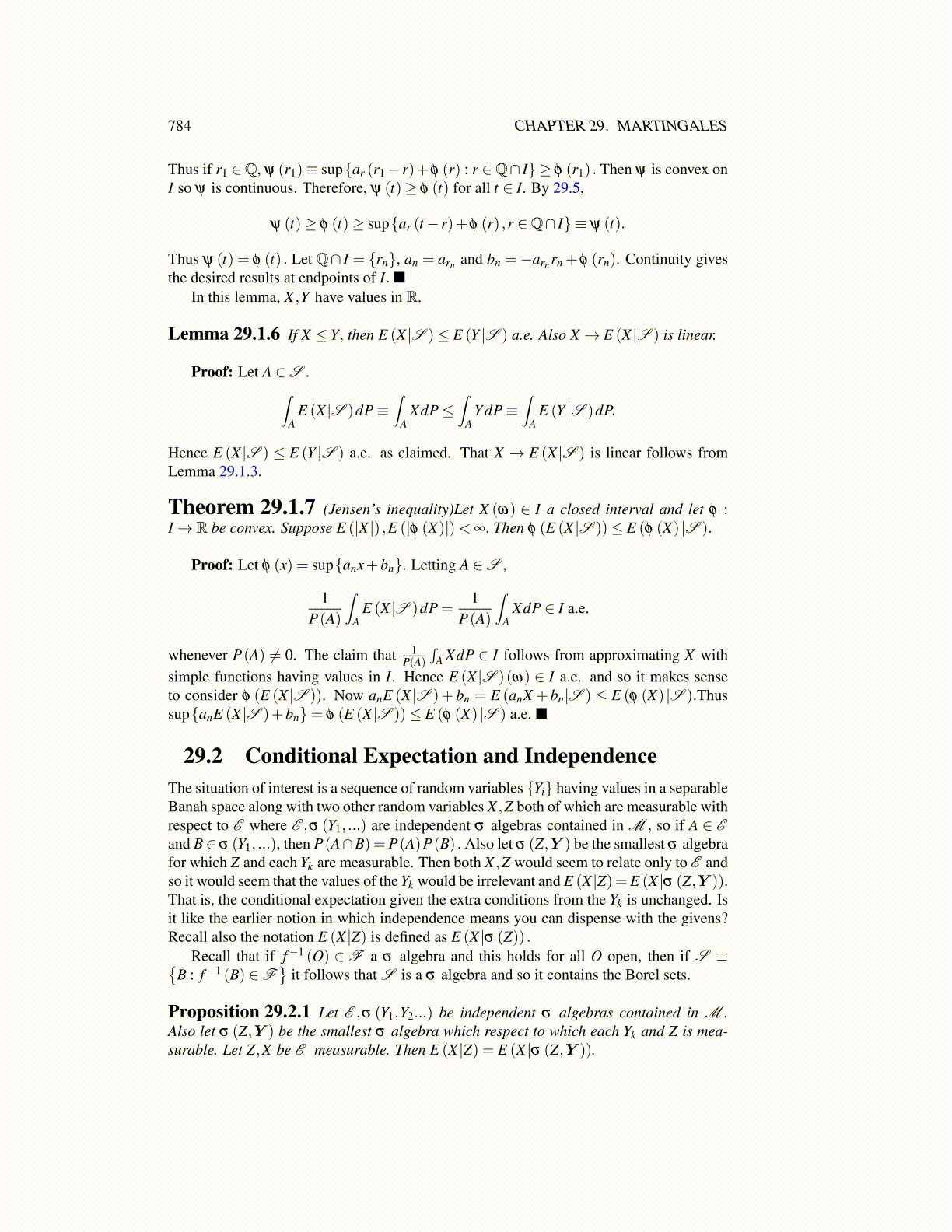
784 CHAPTER 29. MARTINGALES
Thus if r1 ∈Q, ψ (r1)≡ sup{ar (r1− r)+φ (r) : r ∈Q∩ I} ≥ φ (r1) . Then ψ is convex onI so ψ is continuous. Therefore, ψ (t)≥ φ (t) for all t ∈ I. By 29.5,
ψ (t)≥ φ (t)≥ sup{ar (t− r)+φ (r) ,r ∈Q∩ I} ≡ ψ (t).
Thus ψ (t) = φ (t) . Let Q∩ I = {rn}, an = arn and bn =−arnrn +φ (rn). Continuity givesthe desired results at endpoints of I.■
In this lemma, X ,Y have values in R.
Lemma 29.1.6 If X ≤ Y, then E (X |S )≤ E (Y |S ) a.e. Also X → E (X |S ) is linear.
Proof: Let A ∈S .∫A
E (X |S )dP≡∫
AXdP≤
∫A
Y dP≡∫
AE (Y |S )dP.
Hence E (X |S ) ≤ E (Y |S ) a.e. as claimed. That X → E (X |S ) is linear follows fromLemma 29.1.3.
Theorem 29.1.7 (Jensen’s inequality)Let X (ω) ∈ I a closed interval and let φ :I→ R be convex. Suppose E (|X |) ,E (|φ (X)|)< ∞. Then φ (E (X |S ))≤ E (φ (X) |S ).
Proof: Let φ (x) = sup{anx+bn}. Letting A ∈S ,
1P(A)
∫A
E (X |S )dP =1
P(A)
∫A
XdP ∈ I a.e.
whenever P(A) ̸= 0. The claim that 1P(A)
∫A XdP ∈ I follows from approximating X with
simple functions having values in I. Hence E (X |S )(ω) ∈ I a.e. and so it makes senseto consider φ (E (X |S )). Now anE (X |S )+ bn = E (anX +bn|S ) ≤ E (φ (X) |S ).Thussup{anE (X |S )+bn}= φ (E (X |S ))≤ E (φ (X) |S ) a.e. ■
29.2 Conditional Expectation and IndependenceThe situation of interest is a sequence of random variables {Yi} having values in a separableBanah space along with two other random variables X ,Z both of which are measurable withrespect to E where E ,σ (Y1, ...) are independent σ algebras contained in M , so if A ∈ Eand B∈ σ (Y1, ...), then P(A∩B) = P(A)P(B) . Also let σ (Z,Y ) be the smallest σ algebrafor which Z and each Yk are measurable. Then both X ,Z would seem to relate only to E andso it would seem that the values of the Yk would be irrelevant and E (X |Z)=E (X |σ (Z,Y )).That is, the conditional expectation given the extra conditions from the Yk is unchanged. Isit like the earlier notion in which independence means you can dispense with the givens?Recall also the notation E (X |Z) is defined as E (X |σ (Z)) .
Recall that if f−1 (O) ∈ F a σ algebra and this holds for all O open, then if S ≡{B : f−1 (B) ∈F
}it follows that S is a σ algebra and so it contains the Borel sets.
Proposition 29.2.1 Let E ,σ (Y1,Y2...) be independent σ algebras contained in M .Also let σ (Z,Y ) be the smallest σ algebra which respect to which each Yk and Z is mea-surable. Let Z,X be E measurable. Then E (X |Z) = E (X |σ (Z,Y )).